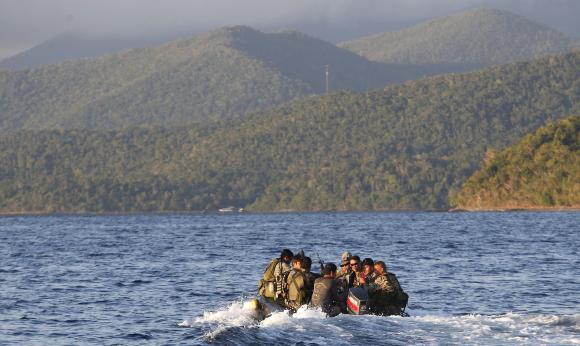SECOND THOMAS SHOAL, South China Sea (Reuters) -The Philippine government vessel made a dash for shallow waters around the disputed reef in the South China Sea, evading two Chinese coastguard ships trying to block its path to deliver food, water and fresh troops to a military outpost on the shoal.

The cat-and-mouse encounter on Saturday, witnessed by Reuters and other media invited onboard the Philippine ship, offered a rare glimpse into the tensions playing out routinely in waters that are one of the region’s biggest flashpoints.
It’s also a reminder of how assertive China has become in pressing its claims to disputed territory far from its mainland.
If we didn’t change direction, if we didn’t change course, then we would have collided with them, Ferdinand Gato, captain of the Philippine vessel, a civilian craft, told Reuters after his boat had anchored on the Second Thomas Shoal under a hot sun.
The outpost is a huge, rusting World War Two transport vessel that the Philippine navy intentionally ran aground in 1999 to mark its claim to the reef.
There, around eight Filipino soldiers live for three months at a time in harsh conditions on a reef that Manila says is within its 200-nautical mile exclusive economic zone (EEZ). China, which claims 90 percent of the South China Sea, says the shoal is part of its territory.
Things were going smoothly for the Philippine ship until it was spotted by a Chinese coastguard ship about an hour away from the Second Thomas Shoal. The Chinese boat picked up speed to come near the left of the white Philippine ship, honking its horn at least three times.
The Chinese ship slowed down after a few minutes, but then a bigger coastguard vessel emerged, moving fast to cut the path of the Philippine boat.
The Chinese sent a radio message to the Filipinos, saying they were entering Chinese territory.
We order you to stop immediately, stop all illegal activities and leave, said the radio message, delivered in English. Gato replied that his mission was to deliver provisions to Philippine troops stationed in the area.
Philippine troops wearing civilian clothes and journalists then flashed V for the peace sign at the Chinese.
WATCHED FROM THE SKY
Instead of stopping or reversing, the Philippine vessel picked up speed and eventually maneuvered away from the Chinese, entering waters that were too shallow for the bigger coastguard ships.
A U.S. navy plane, a Philippine military aircraft and a Chinese plane, all visible from their markings, flew above the ships at different intervals.
Filipino troops on the civilian vessel clapped as they came within a few meters of the marooned transport ship, the BRP Sierra Madre. Supplies of food and water were then hauled up to troops onboard.
Later, the eight soldiers due to be relieved put on military fatigues for a daily ceremony to lower the Philippine flag at dusk.
They had been scheduled to go home three weeks ago but Chinese ships blocked two Philippine supply vessels from reaching them on March 9, a move protested by Manila and which the United States described as provocative. The Philippines resorted to air dropping food and water instead.
What we want to accomplish is for this area to remain ours. This is the one thing that we are guarding here, said sergeant Jerry Fuentes, a Philippine marine set to deploy on the BRP Sierra Madre.
China’s Foreign Ministry said late on Saturday that the action by the Philippines would not change the reality of China’s sovereignty over the shoal, which Beijing calls Ren’ai reef.
China will never tolerate the Philippines’ occupation of the Ren’ai reef in any form, it said.
China displays its claims to the South China Sea on official maps with a so-called nine-dash line that stretches deep into the maritime heart of Southeast Asia.
The ships of its recently unified coastguard are a fixture around the disputed waters. While they don’t have the weaponry of military vessels, thus reducing the risk a confrontation could get out of control, they still represent a potent show of sovereignty.
Vietnam, Malaysia, Brunei and Taiwan also have claims to parts of the potentially energy-rich waters.
Raising the stakes over the South China Sea, the Philippines filed a case against China on Sunday at an arbitration tribunal in The Hague, subjecting Beijing to international legal scrutiny over the waters for the first time.
Manila is seeking a ruling at the Permanent Court of Arbitration to confirm its right to exploit the waters in its EEZ as allowed under the U.N. Convention on the Law of the Sea (UNCLOS), its team of U.S. and British lawyers have said.
China reiterated on Sunday that it would not accept international arbitration, saying the only way to resolve the dispute was through bilateral negotiations.
Regardless of how the Philippines packages its lawsuit, the direct cause of the dispute between China and the Philippines is the Philippines’ illegal occupation of part of the islands in the South China Sea, Foreign Ministry spokesman Hong Lei said in a statement.
The U.S. State Department said all countries should respect the right of any state to use dispute resolution mechanisms under the Convention on the Law of the Sea.
Regardless of the results of this arbitration proceeding, we call on all parties to refrain from taking unilateral actions that are escalatory and destabilizing, spokeswoman Marie Harf said.
Philippines Foreign Secretary Albert del Rosario told a news conference in Manila on Sunday that Manila does not expect the tribunal to reach a decision before the end of 2015.
The question of, what if the Philippines gets a favorable ruling? The Philippines has always taken the position that a favorable ruling is a ruling that China, as a member of the community of nations, is bound legally to accept and to implement, government lawyer Francis Jardeleza said.
(This story was refiled to fix typo in lawyer’s name in final paragraph)
(Additional reporting by Ben Blanchard and Sui-Lee Wee in Beijing and Manuel Mogato in MANILA; Writing by Rosemarie Francisco; Editing by Dean Yates)





